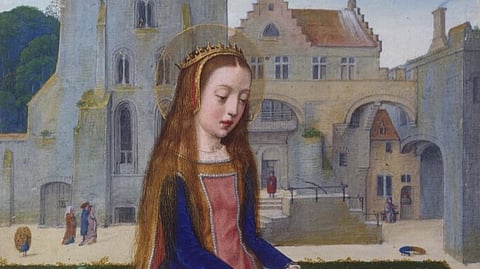
- NEWS
- the EDIT
- COMMENTARY
- BUSINESS
- LIFE
- SHOW
- ACTION
- GLOBAL GOALS
- SNAPS
- DYARYO TIRADA
- MORE

Readings — Rv. 14:1-3, 4-5; Ps. 24:1-2, 3-4, 5-6; Lk. 21:1-4.
Some Notes on St. Catherine of Alexandria (Sta. Catalina) —
1. St. Catherine was martyred at the age of 18 in the 4th century at the hands of the Emperor Maxentius. Her cult as a Saint probably originated in oral traditions from the 4th century persecutions of Christians in Alexandria during the reign of Emperor Diocletian. She was one of the most venerated Saints in the late Middle Ages, and considered the most important of the virgin martyrs, that included St. Agnes of Rome, St. Margaret of Antioch, St. Barbara, St. Lucia of Syracuse, St. Valerie of Limoges, etc. She was one of the “14 Holy Helpers” in heaven venerated for their power of intercession. Much of what we know about St. Catherine comes from tradition and legendary stories. Of Greek and noble origin, she was the daughter of the governor of Alexandria. At an early age, she devoted herself to study and became a noted scholar.
2. Due to a vision of the Virgin Mary and the Child Jesus, she became a Christian. When the Emperor Maxentius began persecuting the Church, she went to Rome and personally rebuked him for his cruelty. Maxentius got 50 of the best philosophers and orators to dispute with her against her Christian beliefs. She not only won the debate but also converted some of her adversaries, who were at once put to death. Maxentius had her tortured and imprisoned. Angels tended her wounds, a dove fed her daily, and Jesus visited her. She converted many of her visitors including the wife of Maxentius and his general, and all were put to death.
3. Finally, Maxentius proposed marriage to her, in order to win her over. But Catherine refused, saying that her spouse was Jesus Christ. So Maxentius condemned her to death on a spiked breaking wheel (her principal symbol). But at her touch, it shattered. Maxentius then ordered her to be beheaded. Angels carried her body to Mt. Sinai.
4. In the 6th century, the Eastern Emperor Justinian built St. Catherine’s Monastery in Egypt, encircling the place of the burning bush seen by Moses. Her relics were rediscovered at the monastery about 800 AD. Different parts of her relics are kept at various shrines. At the beginning of the 15th century, St. Joan of Arc testified that St. Catherine, together with St. Margaret of Antioch, had appeared to her to become her advisors. St. Catherine is the Patron Saint of Philosophers and Scholars. She is also believed to help protect against sudden death.
5. 1st Reading, Rv. 14:1-3, 4-5 — Believers in the Lord, standing on Mt. Zion, are pure of heart. John sees a vision of Jesus, the Lamb of God endowed by his Father, “the Ancient of Days,” with dominion and power, standing on Mount Zion (Jerusalem) with all believers from every nation and race (144,000 from the tribes of Israel). The name of the Lamb and of his father are written on their foreheads (v.1). Then John hears harpists playing and singing a hymn before the heavenly throne, before the 4 living creatures and the elders, a hymn only the 144 thousand knew. These had been “ransomed from the earth,” as the “first fruits of the human race for God and the Lamb.” They are pure and “unblemished“ and “follow the Lamb wherever he goes” (vv. 2-5).
6. Resp. Ps. 24:1-2, 3-4, 5-6 — The pure of heart will go up the mountain of the Lord. The earth, the world and all who dwell in it are the Lord’s (vv. 1). “Who may go up the mountain of the Lord and stand on its holy place?” (v. 3). “The clean of hand and pure of heart” (v. 4). He will receive blessings and justice from the Lord (v. 5).
7. Gospel, Lk. 21:1-4 — The Poor Widow’s Contribution. Teaching at the temple area, Jesus sees some wealthy people putting their offerings into the treasury. He notices a poor widow putting in two small coins (vv. 1-2). Jesus tells his listeners, “I tell you, truly, this poor widow put in more than all the rest; for those others have all made offerings from their surplus wealth, but she, from her poverty, had offered her whole livelihood” (vv. 3-4).
8. In his gospel, Luke especially highlights Jesus’ predilection for the poor. The poor widow is an example. Her detachment and dependence on God leads to her blessedness (see Lk. 6:20, the beatitude of the poor). The offering of her whole livelihood provides a striking contrast to the surplus offerings of the rich.
9. Prayer — Almighty ever-living God, you gave St. Catherine to us as a Virgin and an invincible Martyr. Grant that, through her intercession, we may be pure and unblemished as we offer you everything we have. Strengthen us in faith and constancy to give of ourselves generously to the poor and to spread your Kingdom on earth. This we pray, through Christ our Lord. Amen.
Prayers, best wishes, God bless!
